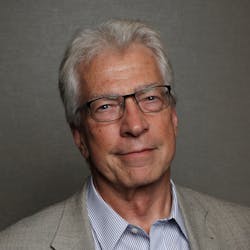The deep-ultraviolet wavelengths have been challenging detector makers for many years. A promising window around 254 nm is “solar blind,” meaning that the atmospheric ozone layer absorbs nearly 100% of the Sun’s energy and a sensor for that region could easily image scenes illuminated with 254 nm light—a wavelength widely available from mercury vapor lamps (and frequently used for germicidal treatment in clinical environments). As our cover story explains, a focal-plane array for this region has been developed by researchers at Northwestern University; the sensor could find application in the inspection of high-voltage power lines and detecting missiles fired at aircraft (see page 15).
Deterring missile threats to aircraft is also the reason for awarding recent contracts for infrared countermeasures based on quantum-cascade lasers (see http://bit.ly/qr55AY). In the civilian world, these mid-IR tunable sources have now been used for spectroscopy applications such as detecting anesthetic gases or identifying hazardous materials (see page 65). Military applications remain a key driver not only of laser development but also of innovations in optical coatings that must satisfy many extreme requirements, especially in the most common of military applications: laser rangefinders (see page 37).
New uses of familiar regions of the spectrum and new applications in less developed regions are both important paths for researchers. The terahertz region—at a far extreme from the UV—has continued to draw explorers. Researchers at AMO in Aachen, Germany, for example, have developed a terahertz reflectometry system that has the accuracy necessary to find sub-micron faults in silicon chips (see page 61).
As researchers and engineers continue to develop new lasers, optics, and detectors, we can safely predict that new applications and advances in established applications will continue to follow.

